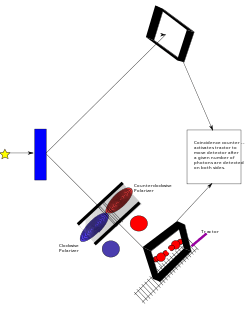Quantum eraser experiment
In quantum mechanics, the quantum eraser experiment is an interferometer experiment that demonstrates several fundamental aspects of the quantum theory, including quantum entanglement and complementarity.
The double-slit quantum eraser experiment described in this article has three stages:[1]
- First of all, the experimenter tries to reproduce the interference pattern of Young's double-slit experiment by shining photons at the double-slit interferometer and check for interference pattern at the detection screen.
- The experimenter marks through which slit each photon went, without disturbing their movement, and demonstrates that the interference pattern is destroyed. This stage shows that it is the existence of the "which-path" information which causes the destruction of the interference pattern.
- The "which-path" information is "erased," whereupon the interference pattern is recovered.
A key result is that it does not matter whether the erasure procedure is done before or after the detection of the photons.[1][2]
Quantum erasure technology can be used to increase the resolution of advanced microscope.[3]
Introduction
The quantum eraser experiment described in this article is a variation of Thomas Young's classic double-slit experiment. It establishes that when a photon is acted upon in a fashion that allows which slit it has passed through to be determined, the photon cannot interfere with itself. When a stream of photons is marked in this way, then the interference fringes characteristic of the Young experiment will not be seen. This experiment displays the capability to create situations in which a photon that has been 'marked' to expose through which slit it has passed can later be 'unmarked'. A photon that has been 'marked' cannot interfere with itself and will not produce fringe patterns, but a photon that has been 'marked' and then 'unmarked' can interfere with itself and will produce the fringes characteristic of Young's experiment.[1]
This experiment involves an apparatus with two main sections. After two entangled photons are created, each is directed into its own section of the apparatus. It then becomes clear that anything done to learn the path of the entangled partner of the photon being examined in the double-slit part of the apparatus will influence the second photon, and vice-versa. The advantage of manipulating the entangled partners of the photons in the double-slit part of the experimental apparatus is that experimenters can destroy or restore the interference pattern in the latter without changing anything in that part of the apparatus. Experimenters do so by manipulating the entangled photon, and they can do so before or after its partner has passed through the slits and other elements of experimental apparatus between the photon emitter and the detection screen. So, under conditions where the double-slit part of the experiment has been set up to prevent the appearance of interference phenomena (because there is definitive "which path" information present), the quantum eraser can be used to effectively erase that information. In doing so, the experimenter restores interference without altering the double-slit part of the experimental apparatus.[1]
A variation of this experiment, delayed choice quantum eraser, allows the decision whether to measure or destroy the "which path" information to be delayed until after the entangled particle partner (the one going through the slits) has either interfered with itself or not.[4] Doing so appears to have the bizarre effect of causing the outcome of an event after the event has already occurred. In other words, something that happens at time t apparently reaches back to some time t - 1 and acts as a determining causal factor at that earlier time.
The experiment

First, a photon is shot through a specialized nonlinear optical device: a beta barium borate (BBO) crystal. This crystal converts the single photon into two entangled photons of lower frequency, a process known as spontaneous parametric down-conversion (SPDC). These entangled photons follow separate paths. One photon goes directly to a detector, while the second photon passes through the double-slit mask to a second detector. Both detectors are connected to a coincidence circuit, ensuring that only entangled photon pairs are counted. A stepper motor moves the second detector to scan across the target area, producing an intensity map. This configuration yields the familiar interference pattern.

Next, a circular polarizer is placed in front of each slit in the double-slit mask, producing clockwise circular polarization in light passing through one slit, and counter-clockwise circular polarization in the other slit (see Figure 1). This polarization is measured at the detector, thus "marking" the photons and destroying the interference pattern (see Fresnel–Arago laws).
Finally, a linear polarizer is introduced in the path of the first photon of the entangled pair, giving this photon a diagonal polarization (see Figure 2). Entanglement ensures a complementary diagonal polarization in its partner, which passes through the double-slit mask. This alters the effect of the circular polarizers: each will produce a mix of clockwise and counter-clockwise polarized light. Thus the second detector can no longer determine which path was taken, and the interference fringes are restored.
See also
- Walborn et al. quantum eraser Another schematic representation of the experiment, one that follows more closely the version given in the original article.
- Delayed choice quantum eraser
- Wheeler's delayed choice experiment
- Marlan Scully
References
- ↑ 1.0 1.1 1.2 1.3 Walborn, S. P.; et al. (2002). "Double-Slit Quantum Eraser". Phys. Rev. A 65 (3): 033818. doi:10.1103/PhysRevA.65.033818.
- ↑ Englert, Berthold-Georg (1999). "REMARKS ON SOME BASIC ISSUES IN QUANTUM MECHANICS". Zeitschrift für Naturforschung 54 (1): 11–32.
- ↑ Aharonov, Yakir; Zubairy, M. Suhail (2005). "Time and the Quantum: Erasing the Past and Impacting the Future". Science 307 (5711): pp. 875–879. doi:10.1126/science.1107787.
- ↑ Kim, Yoon-Ho; R. Yu, S.P. Kulik, Y.H. Shih and Marlan Scully (2000). "A Delayed Choice Quantum Eraser". Physical Review Letters 84: 1–5. arXiv:quant-ph/9903047. Bibcode:2000PhRvL..84....1K. doi:10.1103/PhysRevLett.84.1.
External links
- A more technical analysis of the quantum eraser experiment
- A Scientific American article: A Do-It-Yourself Quantum Eraser - note: SciAm online subscribers only
- but here they let you see the images for free.
- Demystifying the Delayed Choice Experiments